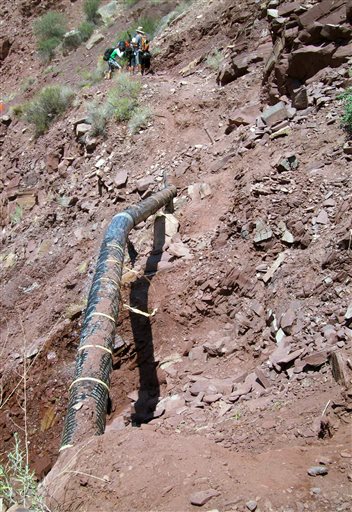 This undated photo shows hikers walking near a water pipeline that runs through Grand Canyon National Park, Arizona. Two pipelines that feed water from a spring deep in the canyon to storage tanks on the rim are the top priority for maintenance in the national park, and replacing them could cost up to $200 million.
This undated photo shows hikers walking near a water pipeline that runs through Grand Canyon National Park, Arizona. Two pipelines that feed water from a spring deep in the canyon to storage tanks on the rim are the top priority for maintenance in the national park, and replacing them could cost up to $200 million.FLAGSTAFF, Ariz. - A busted pipe that cut off a water supply for hikers at the Grand Canyon this week is the latest sign of aging infrastructure that could cost up to $200 million to replace.
Two pipelines that feed water from a spring deep in the canyon to storage tanks on the rim are the top priority for maintenance in the national park, said maintenance chief Tim Jarrell. Grand Canyon officials are stashing away a portion of entrance fees and doing engineering studies to determine how best to move forward.
"The Park Service has recognized that because of the magnitude of it, the implications and the cost to it, it's no longer just Grand Canyon's problem," Jarrell said. "It's the Park Service's problem, so we have everyone's ear."
The pipelines are the primary water source for park staff, visitors, hotel guests and residents at the Grand Canyon. A portion of a steel pipe that runs up to the North Rim burst Tuesday when a rock fell on it. Crews boarded a helicopter with supplies to fix it at a cost of about $25,000, Jarrell said.
Signs along trails let hikers know that water was unavailable near Supai Tunnel until the pipe was fixed Thursday. The next closest water filling stations were at the trailhead for the North Kaibab trail, about 2 miles away and at Roaring Springs, nearly 5 miles away.
The busted pipe didn't create a problem with the water supply on either the South Rim or the North Rim. Storage tanks there hold enough water to sustain the South Rim for 18 days and the North Rim for a month, Jarrell said.
Two major floods in the 1960s and 1990s damaged the pipes to the extent that Grand Canyon officials had to haul water in from nearby cities, Jarrell said.
The steel pipeline that runs up to the North Rim dates back to the 1930s and is subject to rock falls and freezing in the wintertime because it sits above ground. The aluminum pipeline that feeds the South Rim was laid underground in the 1960s, but grit in the water scars the inside through its twists and turns, creating weak spots.
Other national parks, primarily in the eastern U.S., rely on municipal water supplies while more remote parks draw from wells or onsite water sources and have their own water treatment facilities.
Grand Canyon gets its water from an aquifer that feeds Roaring Springs on the northern end of the canyon and through the pipeline system unique to the national park by some 4.5 million people each year. Replacing the system is a top priority for the National Park Service's Intermountain Region, spokesman James Doyle said.
"The delivery system, the age of the system, going from rim to rim is a feat in and of itself," he said. "Certainly this delivery system wasn't designed to last this long, so that makes it challenging as well."
Jarrell said Grand Canyon officials hope to have a study completed this summer that will outline strategies for replacing the pipelines and the actual cost.
"If it's $200 million, it's going to take us a while," he said.
